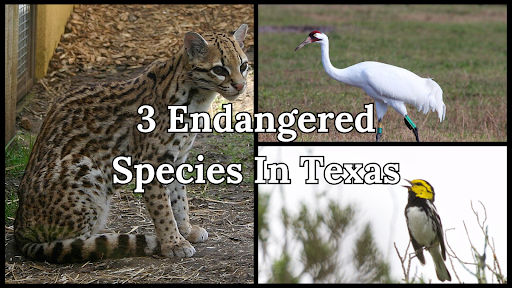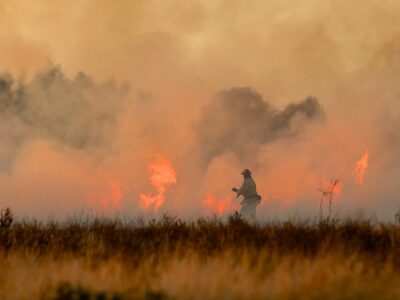Texas is big. The second largest state in the United States (Alaska being first), the Lone Star State is more than one and a half times larger than California. Roughly 30 million Texans live across its approximately 268,580 square miles of land.
The three biggest clusters of residents can be found in Houston, San Antonio, and Dallas — in that order. While Texas will always be associated with barbecue, among other things, it’s also the birthplace of two iconic beverage-related products: Dr. Pepper and frozen margarita machines!
In addition to millions of human inhabitants, the state is also home to millions of animal species ranging in size from longhorns to armadillos to ants.
A small portion of these species are protected under the Endangered Species Act (ESA) of 1973, which safeguards any and all plants and animals that are under threat of extinction.
This status means that any animal listed on the ESA living in Texas is federally protected. The Texas Parks and Wildlife Department also maintains its own state-specific list of threatened and endangered species, which includes all the animals listed on the ESA but has a lot more, too.
In fact, Texas’ state list contains more than 100 species that are also supported by the ESA. For reference, the entire federal list has more than 1,400 species, highlighting the massive size of Texas’ plant and animal population. However, even simply listing every species currently on the state’s list would take hours, so instead, read on to learn about a few of the most interesting — and rare — animals on Texas’ endangered species list.
Golden-cheeked Warbler
Photo Courtesy Bettina Arrigoni
The golden-cheeked warbler (Setophaga chrysoparia) is a visually stunning bird that gets its name from its prominent golden-colored cheeks. It is the only bird species of the approximately 355 living in Texas that nests exclusively in the state. It’s so rare that it’s not only unique to the state but specifically the oak-juniper woodlands found in Central Texas.
The warbler was first listed as endangered in 1990 and has remained there ever since. There isn’t a single factor responsible for its population decline. However, human-caused habitat loss from things like logging, livestock-related grazing, houses, and roads has played the most significant role.
The birds typically migrate south to Mexico and Central America in the winter. But home is where the heart lies, and the golden-cheeked warblers’ hearts lie in central Texas, the location they return to time and time again to nest, breed, and raise their young.
In 1992, just two years after the warblers were placed on the ESA list, the Texas Natural Heritage Program of the Texas Parks and Wildlife Department sent a Golden-Cheeked Warbler Recovery Plan to the U.S. Fish and Wildlife Service (USFWS). Among other things, it called for more studies on the species’ population status, living habitats, current and future threats, the protection of known habitats and breeding grounds, and more regulatory protection.
Although there have not been many initiatives centered around repopulating the warblers or restoring their habitats, there have been a lot of scientific studies on the birds themselves. Interestingly enough, one of those studies from 2012 estimated the population to be around 263,000, which was a bit more than the previous consensus estimate of 27,000 from an earlier study in 2007.
According to the Texas Tribune, the study that found the population to be much higher than previously thought has drawn a bit of controversy. Its lead researcher, Heather Mathewson, said the warblers still faced big habitat threats and shouldn’t have their endangered status dropped. A select few disagreed and have unsuccessfully petitioned for the golden-cheeked birds to be removed from the ESA numerous times over the past decade. Unfortunately for the warblers, these efforts have superseded efforts around their rehabilitation and repopulation.
Ocelot
Photo Courtesy bclarkesmith
The ocelot (Leopardus pardalis) is a majestic-looking cat species found in the Southernmost parts of Texas. The animals resemble miniature versions of cheetahs, weighing anywhere from 15 to 30 pounds and reaching lengths between 30 to 41 inches from head to tail. In the U.S., the cats once roamed not only all of Texas but parts of Louisiana, Arizona, and Arkansas. Ocelot populations were decimated by hunting, trapping, and habitat loss, eventually leading to official endangered status under the ESA on March 3, 1972.
The carnivorous cats hunt at night, preying on rabbits, birds (watch out warblers), and small rodents. They live in home ranges, specific areas ranging from 1 to 4 square miles, and have been known to reach 20 years of age in captivity.
Preferring to live in thick brush has not been a great long-term habit for ocelots, as most of it has been cleared out in favor of farmland and cities. According to the Defenders of Wildlife, worldwide estimates put the entire ocelot population between 800,000 and 1.5 million, but there are less than 100 living in Texas today.
And those remaining in Texas face a different challenge than others: a lack of genetic diversity.
Due to the isolated nature of the species from other populations in Mexico and beyond, the ocelots living in Texas are much more vulnerable to genetic defects from inbreeding-like diseases.
That very problem is being tackled by Recovering Texas Ocelots, a collaborative project between federal, state, university, and private partners geared toward the recovery and repopulation of the cats in the Lone Star state. The project has led to a series of breeding and repopulation initiatives, and the most recent was a pretty big deal. Just a few months ago, the USFWS officially sanctioned an ocelot reintroduction on private lands at the East Foundation’s El Sauz Ranch.
Whooping Crane
Photo Courtesy Sandhillcrane
The tallest bird in North America, the whooping crane (Grus americana), can stand over five feet tall. Spotting the white plumage, black primary feathers, and yellow eyes of these birds is a remarkably rare occurrence and has been for a while.
The fact that these birds still exist today is actually somewhat of a miracle. The whooping crane population totaled about 22 in 1942 and reached an all-time low of 16 a few years later.
Those cranes were all a part of the same flock, which migrated between Canada’s Wood Buffalo National Park and Texas’ Aransas National Wildlife Refuge.
The whooping cranes were facing slim odds of survival, at best, but survived long enough for the USGS Patuxent Wildlife Research Center (PWRC) to devise a plan. In 1967, biologists at the Maryland-based wildlife conservation center collected 12 eggs from the wild. They would then become the first batch of the PWRC’s captive breeding program — hatched into whooping crane chicks, introduced to their preferred wetland habitats, and eventually became a new flock. The breeding program is still active today, and although it’s not in Texas, all the whooping cranes bred there can be traced back to the migratory flock that still lives in Texas.
That group, the Aransas-Wood Buffalo flock, can normally be found residing in Texas’ Aransas National Wildlife Refuge during the winter and some 2,500 miles North in Canada’s Wood Buffalo National Park when it’s not wintertime.
According to a 2021–2022 survey, there were approximately 543 whooping cranes in the flock, which is not only a lot more than 16 but also indicates a stable population from the previous two years. For a bird species that was on the brink of extinction, it’s hard to argue that things aren’t looking a bit better for the majestic birds.





